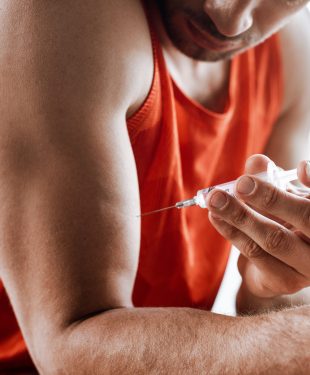Here is your ultimate guide to SARMs. Over the last two years, strength training has become America’s most popular form of exercise. 2022 alone saw a 94% increase in Americans taking strength training classes over the year prior. And those gains don’t appear to be slowing.
Given the current fascination with building strong, lean physiques, there’s a lot of discourse over tools that may help maximize someone’s results. Of late, a class of drugs called SARMs emerged as one of the most popular muscle-building aids. But how much do we know about SARMs? Are they safe and effective?
To help you make an informed decision about using SARMs, here’s everything you need to know about their development, their usage, and the results they can produce.
What are SARMs?
SARM stands for selective androgen receptor modulator. As the name would imply, they’re are a class of drugs that bind to select androgen receptors in the body.
Androgen receptors are a type of specialized protein found within certain cells. They mediate the actions of hormones like testosterone and dihydrotestosterone. This makes androgen receptors crucial to the development and maintenance of the musculoskeletal and cardiovascular systems, among others.
SARMs can either stimulate or block these receptors to achieve various outcomes. Because of the varied effects, they can have on the body, they’re currently being researched for numerous medical applications. These include the treatment of muscle wasting, osteoporosis, and even certain types of cancer.
One of the most prominent benefits of SARMs is their ability to promote rapid muscle growth and prevent muscle wasting. This is because hormones like testosterone are the key drivers of muscle development and maintenance.
By stimulating the androgen receptors that interact with these hormones, SARMs can facilitate explosive gains in muscle size and strength. They can also make it easier to retain those gains. These qualities make SARMs very attractive to athletes and bodybuilders. That is why most athletes often research where to buy SARMs, as well as do the research and ask their doctors and fitness professionals for advice.
These properties may have medicinal applications as well. While not currently approved for general use, a SARM called enobosarm may help to increase muscle mass and improve physical function in older adults with hip fractures. This would make enobosarm a powerful therapeutic tool.
The Development of SARMs
SARMs were discovered in the 1940s. These early compounds were derived from the testosterone molecule, making them steroidal in nature. Before long, drug manufacturers would non-steroidal SARMs, which are the norm today. One of the main benefits that proponents of SARMs cite is that they’re non-steroidal. Hypothetically, this should mean that they don’t have the same slate of side effects.
While SARMs have been around for a long time, they’re best known as amazing muscle-building tools similar to the ones you can find at https://www.suplementosfuriozo.com, can interact with the androgen receptors found in tissues throughout the body. These can include everything from the prostate and reproductive systems to the skin, hair follicles, and sweat glands. They can even affect cardiac muscle, the gastrointestinal system, and organs like the liver or brain.
That they can affect so many parts of the body led researchers to develop a host of SARM-based therapies. The first notable example was the treatment of male hypogonadism. This is a condition where the body doesn’t produce enough testosterone. It can be congenital, or it can be the result of an illness, injury, or other condition later in life.
Hypogonadism causes the loss of muscle mass and definition, fat gain, loss of libido, and depression. By using SARMs, researchers were able to boost testosterone to healthy levels, reversing many of these effects.
The Results You Can Expect From SARMs
 For fitness or bodybuilding, SARMs offer three main benefits, increased muscle mass, increased bone mass to support those muscles, and decreased fat mass. Unfortunately, there isn’t a wealth of research concerning using SARMs for athletic development. You should be wary of any product that makes outrageous claims like, “You can pack on pounds of muscle in only six weeks”. If something sounds too good to be true, it almost always is.
For fitness or bodybuilding, SARMs offer three main benefits, increased muscle mass, increased bone mass to support those muscles, and decreased fat mass. Unfortunately, there isn’t a wealth of research concerning using SARMs for athletic development. You should be wary of any product that makes outrageous claims like, “You can pack on pounds of muscle in only six weeks”. If something sounds too good to be true, it almost always is.
Although there isn’t enough hard research to support some of these claims, there is a lot of anecdotal evidence to support SARMs’ efficacy. And our understanding of how SARMs function is consistent with many of these reports.
That said, several other drugs or treatments offer similar benefits. Testosterone replacement therapy is one. Anabolic steroids are another. You might fairly ask why you should opt for SARMs over those alternatives. The most obvious one is that SARMs are legal. Steroids and hormone replacement therapy, on the other hand, are only accessible with a doctor’s prescription. Simple possession of illicit steroids can net you up to a year in jail and a $1,000 fine for a first offense.
No amount of gains is worth the loss of your freedom, even temporarily. That aspect alone makes SARMs an appealing choice. But even setting that aside, there are practical reasons why you may want to opt for SARMs over steroids.
The Steroid Question
Anabolic steroids are a class of synthetic drugs that work by mimicking the effects of testosterone. While they have some legitimate medical uses, they’re most famous for helping bodybuilders, athletes, and even actors achieve physiques that would not normally be feasible.
On paper, they sound a lot like SARMs. Both have therapeutic applications, like treating muscle loss caused by chronic illness. And both can speed up muscle growth while shredding body fat.
The big difference is the side effects that come with those capabilities. Steroids are notorious for their litany of drawbacks. For example, a survey of professional hockey players found higher rates of joint and ligament injuries in those who admitted to using steroids.
Researchers think this is because steroids cause muscles to grow faster than the body can create the cartilage needed to support them. Players would get so strong so fast that they literally started tearing their own joints. Steroid abuse is also linked to liver damage, high blood pressure, infertility, and aggressive outbursts, among other drawbacks.
Steroids vs SARMs
 Some of these adverse effects are thought to be because steroids cannot target specific parts of the body. An abundance of artificial testosterone will increase muscle mass and bone density, sure. But it can also cause the kind of havoc you would expect from a serious hormonal imbalance.
Some of these adverse effects are thought to be because steroids cannot target specific parts of the body. An abundance of artificial testosterone will increase muscle mass and bone density, sure. But it can also cause the kind of havoc you would expect from a serious hormonal imbalance.
By contrast, SARMs allow for a more specialized approach. These drugs can be tailored to target specific tissues like muscle and bone to a far greater extent than steroids.
SARMs also tend not to cause muscle tissue to grow out of proportion to the joints and ligaments that support them. This should make them less likely to result in injury than steroids.
Potential Side Effects and Drawbacks of SARMs
No drug, no matter how innocuous, is without risks. Particularly when it’s used over a long period. Even baby aspirin once recommended to help prevent heart issues, carries a risk of significant side effects.
In the interest of doing your due diligence before trying SARMs, here are some possible concerns to keep in mind.
SARMs Are Banned in Athletic Competition
While this is not a health concern, it is something that anyone with athletic ambitions should keep in mind.
All SARMs are banned by the United States Anti-Doping Agency at all times. It doesn’t matter if an athlete is actively participating in a competition, training for an upcoming competition, or merely trying to maintain the physique in between seasons. The National Collegiate Athletic Association (NCAA) has a similar ban in place, as do most international athletic committees.
Because there are no FDA-approved SARMs available by prescription, and all SARMs are classified as investigational drugs, exceptions to these rules are exceedingly rare. The only possible way around this restriction is for an athlete to volunteer for a clinical trial involving SARMs and to seek a special exemption from the relevant authority. And even then, they should consider it a long shot.
SARMs are also very easy to test for, so don’t count on finding a workaround there, either. They can show up in common anti-doping drug tests weeks after the participant took their last dose.
Not All SARMs Are Created Equal
It’s important to remember that SARMs are not FDA-approved. That doesn’t mean that they have no value or are not effective. But it does mean that they’re not subject to the same scrutiny as other drugs.
Unscrupulous vendors have been caught selling SARM compounds contaminated with steroids or other illicit substances. Other dealers may pass off cheap counterfeits as real SARMs. That’s why if you do use these products, you should opt for a pure, high-quality option like rad140.
Hair Loss
 Hair loss is common in both men and women as they age. Common causes can include genetics or pollution. But the loss of hormones that comes with growing old is often the primary factor.
Hair loss is common in both men and women as they age. Common causes can include genetics or pollution. But the loss of hormones that comes with growing old is often the primary factor.
Using SARMs can help trigger hormone-related hair loss early by reducing the amounts of certain sex hormones. The problem can be exacerbated by taking a high doasage of SARMs or by taking them over a long period.
Gynecomastia in Men
That SARMs could cause gynecomastia in men may come as a surprise. This is due to the conversion of testosterone to estrogen and dihydrotestosterone (DHT).
When a man takes SARMs, the supplement takes up a large portion of the androgen receptors in the body. This can reduce the number of available receptors for testosterone to bind to. Hence, the remaining testosterone may be transformed into estrogen and DHT.
In addition, taking high doses of SARMs may cause more testosterone to remain unbound. This leads to elevated estrogen levels in men. Elevated estrogen levels can not only cause gynecomastia but a host of other hormone-related health problems.
May Suppress Natural Testosterone Production
Taking SARMs the levels of androgens in the body. That’s what causes the positive outcomes we associate with the drugs. But over time, this can cause the body to produce fewer natural androgens on its own.
You see similar phenomena in other naturally occurring hormones. If the body is flush with a substance, it will assume that it has all it needs regardless of the source. Producing hormones takes energy, which your body is programmed to avoid using if it doesn’t think it needs to.
In this case, the body sends a signal to decrease natural testosterone production. It thinks it already has an abundance, so it won’t waste energy producing more. If you stop taking SARMs, however, your body won’t know to ramp up production again.
Over time, you may even start exhibiting the symptoms of low testosterone even while on SARMs.
May Cause Acne
We all remember being oily, hormonal teens. Unfortunately, taking SARMs can cause some people to regress back to that awkward stage of development.
Not unlike hair loss, acne development is governed by hormone levels. Elevated androgen levels in the body, which can result from using SARMs, can increase the amount of sebum produced by the skin. This is the main cause of clogged pores and the formation of acne.
Maximizing Your Workout
While SARMs are popular in the fitness world, it bears repeating that they may come with unintended consequences. While they’re thought to be safer than steroids, there isn’t enough research to say they’re without long-term risks.
At the same time, SARMs’ potential to increase lean muscle growth, burn fat, and reduce recovery time is promising. Whether the reward is worth the potential risk is a discussion you should have with a physician. Want to learn more fitness tips and tricks? Then make sure to explore what the rest of our site has to offer.
Read more lifestyle and health articles at ClichéMag.com
Images provided by BingAI, Adobe Stock, Flickr, Unsplash, Pexels, Pixabay & Creative Commons




